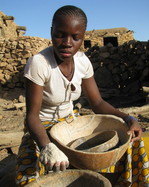Jus de gingembre
3 CommentsOne of the many good things about travelling in Senegal was the widespread availability of fresh fruit, root and flower juices, typically sold in small plastic bags by smiley, buxom ladies on street corners. At first perplexed as to how one drinks from a plastic bag, we soon learnt you nip off a corner with your teeth and then suck out the delicious juice as you continue round the market. Nothing could be better on a hot, dusty day.
 Ginger was our favourite; its intense zinginess can’t fail to jolt you awake and fill you with an overwhelming sense of vitality. Also excellent were bouye (made from the fruit of the giant baobab tree), ditakh (some kind of cucumbery tasting fruit we never identified), and bissap (infused with dried, crimson hibiscus flowers, often with mint).
Ginger was our favourite; its intense zinginess can’t fail to jolt you awake and fill you with an overwhelming sense of vitality. Also excellent were bouye (made from the fruit of the giant baobab tree), ditakh (some kind of cucumbery tasting fruit we never identified), and bissap (infused with dried, crimson hibiscus flowers, often with mint).











